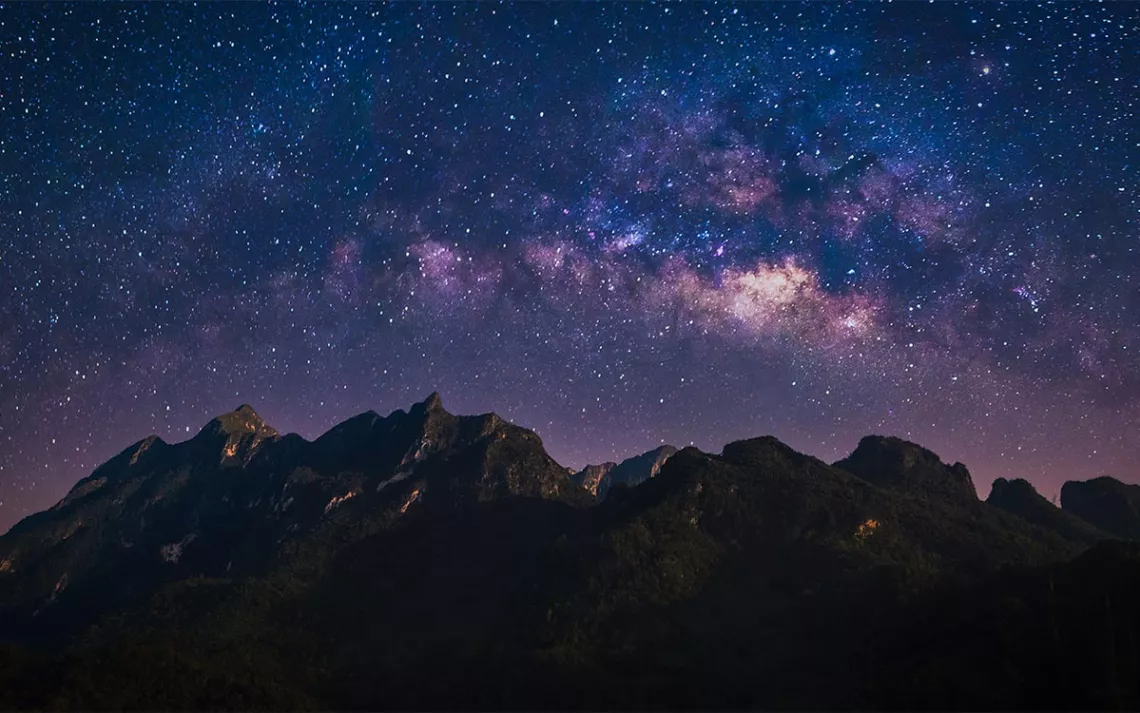April Astronomical Highlights: A Planet or Two, and Lots of Stars
It’s a good month, and epoch, for stargazing

Photo by teddybearpicnic/iStock
The night sky in April is more about stars than planets, unless you want to stay up very late or get up very early. The only planet readily visible is Mars, as a point of reddish light in Taurus to the west. Aldebaran is the other bright-red object in Taurus, and it outshines Mars. But it stays put, while Mars floats across the constellation throughout April, passing close to the Pleiades star cluster at the beginning of the month.
On April 1 and 2 before sunrise, an old crescent moon sets not far from brilliant Venus and neighboring Mercury. Then on April 8 and 9, it passes through Taurus and near the Pleiades, Mars, and V-shaped Hyades cluster. April’s full moon will look most full first thing in the morning on April 19 as it’s setting and the sun is rising. By evening, the full moon will rise in the east and be slightly smaller as it begins to wane. The bright star Spica in Virgo keeps the full moon company all night on the 19th.
Around midnight on April 23, the moon rises alongside Jupiter. In the wee hours of April 25, the moon, paired with Saturn, drifts across the night sky. On the same night, Pluto, invisible except with extra-large telescopes, lurks about as far from Saturn to the lower left as the moon is to Saturn’s lower right. As an added bonus for staying up past the witching hour, you might even spy some Lyrid meteors—the shower’s peak occurs between April 16 and 25.
The Future of Stargazing
Astronomically speaking, April is a quiet month, so now is as good a time as any to take a step back and examine the big picture.
In 1 billion years, the Andromeda Galaxy will become a large feature in the night sky, no longer requiring perfect darkness to see without optical aid. In 4 billion years, as it looms bigger and bigger on the horizon, the outer bands of its arms will mingle with the Milky Way, and the distinct outline of the two galaxies will no longer exist. As the two giant spirals mesh together, the sky will be filled with exploding clusters of stars being born. In 7 billion years, Andromeda and the Milky Way will become one giant elliptical galaxy, with the central core glowing brightly in the sky and changing the definition of “night.”
Although it’s fair to feel a little cheated that we won’t be around to see this amazing show, we’re still viewing the sky at a unique time in history, just by getting to see stars at all. One day in the unfathomably distant future, the expanding universe will spread the stars so far apart that they’ll slip beyond the observable horizon, blinking out one by one until we’re floating alone in the dark expanse of space. Of course that’s assuming that somehow Earth survives the fate of an expanding red giant sun in 7 to 8 billion years. And it definitely won’t survive the cosmos’s continuing expansion, which is predicted to end with the heat death of the universe and the big rip, when even subatomic particles and spacetime itself is destroyed. So maybe now is not such a bad time to be stargazing after all.
One of the unique sights we get to see now that won’t exist in 600 million years is the total solar eclipse. The moon is approximately 400 times smaller than the sun, but it also happens to be 400 times closer to us, so that when the two align just right, the moon makes the sun briefly wink out. Every year, the moon moves almost four centimeters farther from Earth, so in 600 million years, it will be too small in our sky to completely block the sun, leading to the end of total solar eclipses.
The sky’s topography is changing all the time—at any moment, one of the distant stars above our heads may go supernova, flaring brightly and then fading down to nothing. So go outside tonight and look up at the stars while you can.
 The Magazine of The Sierra Club
The Magazine of The Sierra Club







